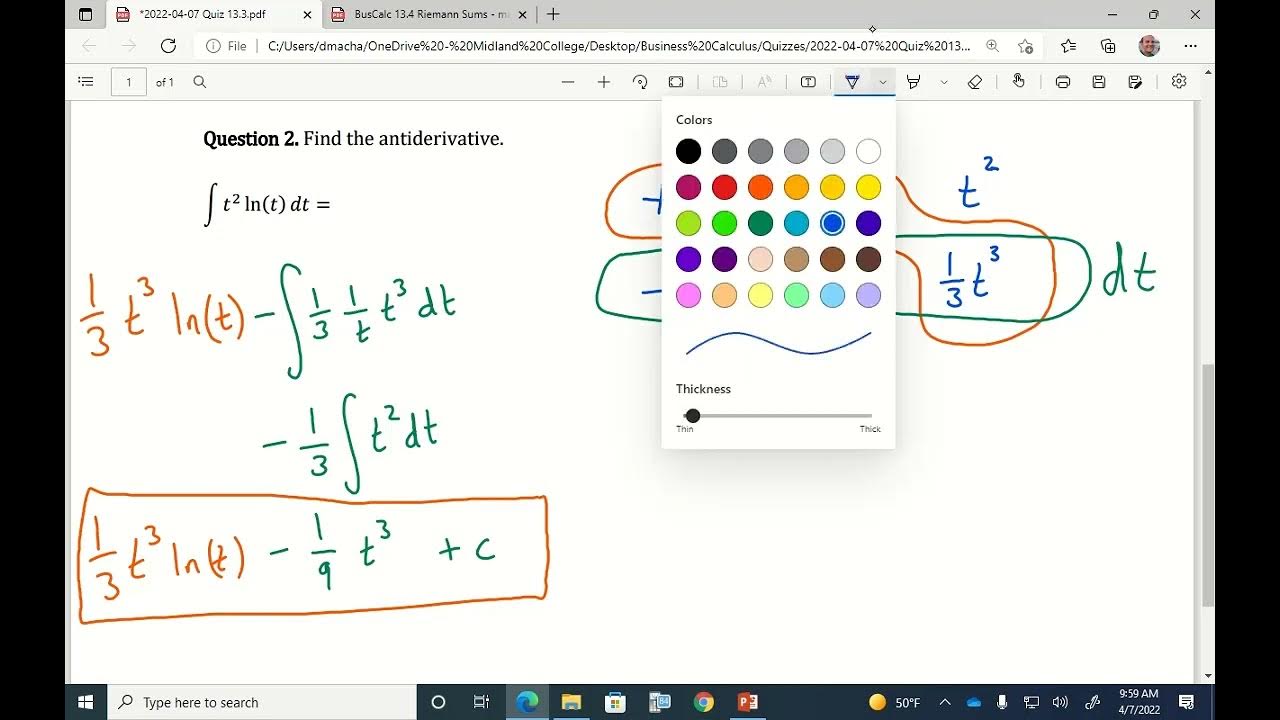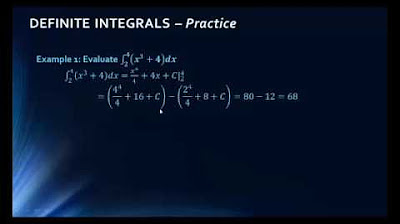Finding The Area Using The Limit Definition & Sigma Notation
TLDRThe video script explains the process of finding the area under a curve using the limit definition. It illustrates the concept with the function f(x) = x^3 over the closed interval from 0 to 8. The explanation includes calculating the area as the limit of the sum of rectangles' areas as the number of rectangles approaches infinity. The script also details the use of right endpoints and the summation formula for i^3, leading to the correct area calculation. The process is further validated by comparing it with the result of the definite integral.
Takeaways
- 📊 The video focuses on finding the area under a curve using the limit definition.
- 🧩 The area of the shaded region between the x-axis and a curve over a closed interval can be found using the limit of the sum of rectangles' areas.
- 📈 The formula for calculating the area is the limit as n approaches infinity of the sum of f(x_i) * Δx, where f(x_i) is the height and Δx is the width of the rectangles.
- 🔢 For right endpoints, x_i is calculated as a + Δx * i, where 'a' is the start of the interval and 'b' is the end.
- 🎨 The illustration in the video uses the function f(x) = x^3 on the interval [0, 8] with n=4 for demonstration purposes.
- 📝 The width of each subinterval, Δx, is calculated as (b - a) / n.
- 🛠️ The actual problem involves letting n approach infinity, leaving Δx as 8/n.
- 📊 The summation formula for i^3 from i=1 to n is (n^2 * (n + 1)^2) / 4.
- 🔍 The limit and summation are applied to find the area, which simplifies to 1024.
- 🔧 The video also suggests confirming the result by calculating the definite integral of the function from a to b, which yields the same result.
- 🎓 For more information on summation formulas, the video recommends referring to a related video on the topic.
Q & A
What is the main focus of the video?
-The main focus of the video is to explain how to find the area under a curve using the limit definition, specifically for the function f(x) = x^3 over the closed interval from 0 to 8.
What is the formula for calculating the area under a curve using the limit definition?
-The formula for calculating the area under a curve using the limit definition is the limit as n approaches infinity of the sum of the rectangles' areas, which is given by ∑(f(x_i) * Δx) from i=1 to n, where f(x_i) is the height of the rectangle and Δx is its width.
How is the width of each subinterval (Δx) calculated?
-The width of each subinterval (Δx) is calculated as (b - a) / n, where 'a' is the start of the interval, 'b' is the end, and 'n' is the number of rectangles.
What are the two different types of endpoints that can be used in the calculation?
-The two different types of endpoints that can be used in the calculation are the right endpoints and the left endpoints.
How is the x-coordinate for a right endpoint calculated?
-The x-coordinate for a right endpoint is calculated as 'a' plus 'Δx' times 'i', where 'a' is the start of the interval and 'i' is the subscript of the point.
What is the significance of the summation formula in this context?
-The summation formula is used to find the sum of the areas of the rectangles, which is necessary for applying the limit definition to find the area under the curve.
How is the summation formula for i^3 from i=1 to n expressed?
-The summation formula for i^3 from i=1 to n is given by (n^2 * (n + 1)^2) / 4.
What is the anti-derivative of f(x) = x^3?
-The anti-derivative of f(x) = x^3 is F(x) = x^4/4 + C, where C is the constant of integration.
How does the definite integral confirm the area calculated using the limit definition?
-The definite integral confirms the area by evaluating the antiderivative of the function over the interval, which should yield the same result as the limit definition if calculated correctly.
What is the final calculated area under the curve using the limit definition?
-The final calculated area under the curve using the limit definition is 1024 square units.
What is the result of evaluating the definite integral of f(x) = x^3 from 0 to 8?
-The result of evaluating the definite integral of f(x) = x^3 from 0 to 8 is 4096/4 - 0 = 1024.
Outlines
📊 Introduction to Finding Area Using Limit Definition
This paragraph introduces the concept of finding the area of a shaded region between the x-axis and a curve over a closed interval using the limit definition. It sets the stage for the problem by presenting a function, x cube, and the interval from 0 to 8. The paragraph explains that the area can be approximated using an infinite number of rectangles, with the height represented by the function value at each point and the width by delta x. The key formula for calculating the area is introduced, which involves the sum of rectangles' areas as n approaches infinity. The paragraph also explains how to find x sub i for right endpoints and illustrates this with a number line example where n is 4, calculating delta x and the x values for each subinterval.
📐 Calculating x sub i and Delta x for Right Endpoints
This paragraph delves into the specifics of calculating x sub i and delta x for right endpoints in the process of finding the area under a curve. It continues from the previous example, explaining how to determine x sub i along the number line and how to calculate delta x when the interval extends to infinity. The paragraph walks through the process of evaluating the function at each x sub i value over the interval from 0 to 8 and emphasizes the importance of using the summation formula for i cubed. It also provides a detailed explanation of how to apply the limit as n approaches infinity to the summation, leading to the calculation of the area.
🔢 Confirmation of Area Through Definite Integral
The final paragraph focuses on confirming the calculated area using the definite integral of the function. It explains that the area under the curve is equal to the definite integral of the function from a to b. The paragraph provides a step-by-step calculation of the definite integral by finding the antiderivative of x cubed and evaluating it between the interval's endpoints. The result obtained from the definite integral is compared with the area calculated using the limit definition, confirming the accuracy of the previous calculation. The paragraph emphasizes the efficiency of using definite integrals for such problems but also highlights the importance of understanding the limit definition as a foundational concept.
Mindmap
Keywords
💡Limit definition
💡Rectangles
💡Delta x
💡Right endpoints
💡Summation formula
💡Definite integral
💡Anti-derivative
💡Closed interval
💡Function values
💡Sigma notation
💡Area calculation
Highlights
The video focuses on finding the area using the limit definition.
The function of interest is x cubed, and the interval is from 0 to 8.
The area of the shaded region is approximated by summing the areas of rectangles.
The limit definition involves an infinite number of rectangles to approximate the area under the curve.
The width of each rectangle is represented by delta x.
The height of the rectangle is given by the function value at each point, f(x_sub_i).
For the illustration, n is set to 4, and the interval is divided into 4 subintervals.
Delta x is calculated as (b - a) / n, which in this case is 8 / 4 = 2.
The right endpoints are used for simplicity in the illustration.
The x values for the right endpoints are 2, 4, 6, and 8.
The area calculation involves the limit as n approaches infinity.
The summation notation (sigma) is introduced for the sum of the areas of the rectangles.
The summation formula for i cubed is applied to find the area.
The final area calculation is 1024, using the summation and limit definition.
The area is confirmed by calculating the definite integral of the function from 0 to 8.
The anti-derivative of x cubed is x to the fourth over 4.
The definite integral confirms the area is 1024, matching the previous calculation.
Transcripts
5.0 / 5 (0 votes)
Thanks for rating:





